#miniature bernese mountain dog
Text
Bernese Mountain Dog vs Swiss Mountain Dog
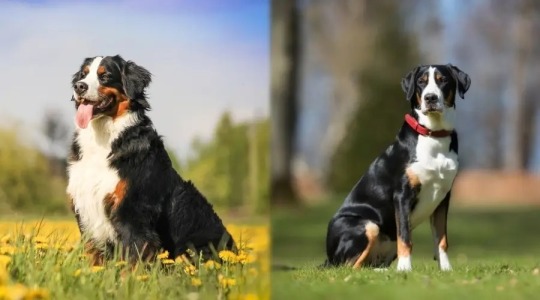
Meta Description
Bernese mountain dogs are one of four canine breeds. They are collectively referred to as Swiss mountain dogs.
What characterizes a Bernese Mountains Dog from a Bigger Swiss Mountain Dog?
When adding the component to your extended family. Are you thinking of a Swiss Mountain Dog or a Bernese Mountain Dog? Let's examine the distinctions and parallels between these two outstanding breeds.
The Greater Swiss Mountain Dog has its origins in Julius Caesar's war canines. Which he used to lead his forces across the Alps in an attempt to bring down Europe. These dogs, inherited from Cesar's mastiff dogs, were employed by the Swiss. To pull carts filled with dairy and meat goods up the mountains to the marketplace. Their journey has become known as "the destitute male horse" as a result.
Although Switzerland has produced numerous amazing dog breeds. None is certainly as well-known as the enormous, tricolored Bernese Mountain Dog. These stunning and loving canines are easy. Recognized by their striking markings and size, they are well-suited for hard work. However, there is another Swiss breed that shares its cultural roots and appearance. People occasionally mistake the Greater Swiss Mountain Dog, a devoted. And powerful member of the Working Group, for a Bernese. Continue reading to find out how to distinguish between these two Swiss Alps dogs.
Closely linked to the Greater Swiss, the Bernese Mountain Dog is native. To an area of Switzerland well-known for its chocolate and cheese. The Bernese were employed for both livestock and pulling. Both are Saint Bernard and Rottweiler foundation breeds.
A Short History of The Bernese Mountain Dog
The Appenzeller Sennenhund, Entlebucher Mountains Dog, Greater Swiss Mountain Dog. Bernese Mountain Dog are the four representatives of the tricolored species. Of Swiss mountain dogs. In the past, Swiss Mountain dogs served as general-purpose farm dogs. For their families, driving animals, pulling milk wagons. And keeping an eye on the property and wildlife. The Bernese Mountain Dog is thought to have originated from a mix. Of certain native Swiss mountain agricultural dogs and big old Roman military dogs. They were introduced to the region about 2000 years ago. During the Roman conquest of Helvetia (modern-day Switzerland). Large canines with exceptional power and endurance were the product of the cross.
Some referred to them as the Clydesdales of the canine world because of their skill at carting. The Bernese Mountain Dog was originally named the Durbacher after a location. Where the breed's predecessors were most prevalent and preferred. Has a lengthy and fascinating history. They were also referred to as Berner Sennenhunde. Which means "Mountain Pasture dog of Berne" in German. Eventually, the Canton of Berne, a region in Switzerland. Where the type of dog originated, came to be renowned.
In the past, there were many Bernese Mountain Dogs in their own country. Still, the breed's popularity started to decline. It was almost eliminated in the middle of the nineteenth century as a result of changes. In agricultural technology. And a lack of official initiatives to breed. Nonetheless, the breed was saved from extinction by Professor Albert Heim and Swiss cynologist Herr Franz Schertenleib. The popularity of the Bernese Mountain Dog started to rise gradually. Farmers from all over the region began bringing their Dürrbächler dogs to dog shows. At the beginning of the 20th century, they also took part in breeding initiatives to improve the breed. The Schweizerischer Dürrbäch-Klub was eventually established, and the breed's standard was created. It was later established that the proper moniker given to the breed is Berner Sennenhund, and this continues to be how the breed is known in its country of origin. The Bernese Mountain Dog, or BMD as it is called in the West, is one of the most widely recognized breeds in all of humanity today.
An Overview of the Greater Swiss Mountain Dog's History
The Greater Swiss Mountain Dog originated from Mastiff-type canines that were employed 2000 years ago in Roman armies. Out of the four varieties of Swiss Mountain Dogs, they are the biggest and the oldest. They were developed to drive livestock, serve as security dogs, and be draft dogs. Before two specimens were given to Dr. Albert Heim, who identified the breed and had it registered with the Swiss Cynological Society in 1909, this breed was on the edge of destruction in the late 1800s. The Fédération Cynologique Internationale released the first standard in 1939. Because of their dependable, peaceful nature, these dogs are now mostly bred for relationships, but they were once valued for their ability to protect.
Comparable appearance and place of origin
Under the prefix Nashem, Sara Karl, an AKC judge and the AKC representative for the Bernese Mountain Dog Club of America, has been producing and exhibiting Bernese since 1986. "Only when the Berner is removed from coat," she responds when asked if people frequently mix up the Bernese Mountain Dog and the Greater Swiss Mountain Dog.
The primary similarity between the two breeds, according to Karl, who has bred over 100 leaders, performance-titled Berners, and two National Specialty winners, is their physical characteristics and traditional purpose. They are equally enormous breeds of canines in black, red, and white. They are both Swiss canines that were created to be used for pushing carts filled with products to markets.
However, Liz Coit, an AKC breeder of excellence and member of the Greater Swiss Mountain Dog Club of America, pointed out that the Berner is a more popular breed than the Swissy and, therefore, more recognizable to most people. Frequently, people inquire as to whether the Swissy is a Berner or, better yet, a shaved Berner. Naturally, when a Swissy is a puppy, it's frequently mistaken for a Beagle, and when it's an adult, for a Saint Bernard. Therefore, I believe the problem is the Swissy's unfamiliarity with the wider population.
Coit, who owns three Swissies, among them Shine, the 2020 Ambassador of the Breed winner, concurs that the breed's appearance and background as farm dogs are similar. Regarding both breeds, she states, "They are recognized for their eye-catching tricolor coats and attitude." They have gone to market and greeted friends and customers who visited the farm, despite being incredibly committed and devoted to their families. Both act as watchful guards, alerting the family to any imagined threats or even just a shift in the wind's direction.
Variations in Coat and Character
Even though many confuse the Swissy for the Berner, there are distinct structural differences. The Greater Swiss Mountain Dog breed guideline states that male Swissies should weigh between 115 and 140 pounds and have a shoulder height of up to 28.5 inches. Male Berners can grow to a height of 27.5 inches and weigh between 80 and 115 pounds. They are slightly smaller than other breeds.
Another notable distinction between the breeds is their coats. While the Swissy has a smaller double coat, the Bernese has a longer one. As Coit notes, both have a dense undercoat, thus a significant amount of shedding is to be expected. She goes on, saying, "There are some differences between the Swissy and Berner standards, such as the markings (which are brown and white) and head form. Compared to Berner breeders, we are more tolerant of marking diversity in Swissies, and naturally, our coat is not as defining a characteristic as it is in Berners.
The Swissy has a more intense industrial temperament than the other breed, even though both are friendly with youngsters and devoted to their families. While the Swissy breed standard refers to them as "alert and vigilant," the Bernese Mountain Dog breed regulation characterizes Berners as "alert and good-natured." Furthermore, the questioning Swissy is more eager to make strangers with new individuals than the aloof Berner. Karl claims that while both are straightforward to train and get along well with people, "Bernese are a little sweeter than the Greater Swiss."
Dedicated and Caring for Dogs
In the Swiss region of Bern, the Berner breed of farm dog was developed for all-around use. Karl claims that farmers employed them for farm security, pulling carts of milk and cheese to markets, and moving milk cows from a particular pasture to another. Possibly because of their history of collaborating closely with farmers, this kind and affectionate breed is committed to its family.
Karl believes that the breed's attributes of beauty, stockiness, and love apply to them. She claims that having a Berner requires a lot of hair loss. She recommends leather seating and an excellent vacuum. She claims that although these dogs enjoy going on walks and travels and enjoying the cold, they don't enjoy being left outside by themselves for long periods. They are also adversely affected by hot temperatures. Although they may survive in warmer climates, you should keep them out of the sun during the hottest parts of the day.
According to Coit, among the Sennehund breeds (Swiss mountain dogs), the Swissy is one of the oldest and biggest. They were also bred to be all-purpose farm dogs, trained to perform duties including herding, transporting milk carts, driving livestock to markets, and simply keeping an eye on the home and property. The Swissy's harsh bark of caution and alertness serves as a sentinel, a legacy of its guardian pedigree.
Like their breed, they are devoted and caring and yearn to be with the people they love. According to Coit, as long as they have long walks in the morning and at night, they are content to laze around all day rather than being busy dogs. They will love it too, though, if you educate them on how to do drafts or herd or take them climbing every day. Since they were bred as shepherd dogs, they tend to gather kids, thus it's critical to teach them how to walk on a slack connection.
For experienced owners or owners prepared to learn everything these huge breeds demand, both types may make wonderful companions. To ensure that the pet you take home is fit and well-bred, though, do your homework on prospective breeders. Karl recommends using Bernergarde.org to look up possible breeders of Berners. And now you can recognize the differences between these strong Swiss breeds, should you be lucky enough to meet one, regardless of whether they're the ideal fit for you.
Lifestyle, Instruction, and Temperament
Because of their affectionate nature and commitment to their families, both kinds are highly valued. In terms of stature and disposition, the Swiss are a little more threatening. They are devoted guardians who are a little darker in spirit but not unfriendly. These strong dogs tend to go through the puppy stage more slowly, and they have a booming bark that your neighbors could not enjoy. Due to their size, they may test a parent's tolerance throughout this protracted puppy stage. At 100 pounds, their ungainly, awkward bodies might make bumps and huge paws too much for them to handle.
It's well known that Bernese Mountain Dogs are more reserved, easygoing, and extremely mindful of their body language when around young children, much like a teddy bear. Although both breeds make wonderful family pets, the Bernese would prevail in the Gentle Giant battle over the Swiss.
Instruction
When it comes to training, food is a terrific motivation to assist teach positive habits in Swiss Mountain Dogs, which can be a bit more resistant , and should start training young. They pull stronger when wearing a safety harness throughout leash training and don't react well to them unless they are being hauled.
Similar to Swiss dogs, Bernese are intelligent canines that are more motivated to please their owners. They are more vulnerable to criticism and separation because of their loving disposition. If they are left alone for extended periods, they will exhibit undesirable behaviors because they would like to be with the family.
Work out
Both breeds need an average amount of daily activity. They work well for owners who enjoy taking their dogs for peaceful walks or hikes in the outdoors, but they are not the best fit for serious bikers and joggers who like training alongside their pets. Both make excellent camping dogs, and they can even tow children and camping supplies in a wagon.
Every day, the Berner and the Swissy require one hour of exercise. Whether or whether there is snowfall on the ground makes no difference in fact, they would both like it. They require long, leisurely walks through the nearby park or natural reserve because they are big dog breeds. They both enjoy being outside and will develop cabin fever if kept indoors for an extended period.
Due to their huge bodies and joints, neither one of them should be trained aggressively while they are puppies. The best course of action is to completely avoid physically demanding tasks because too much pressure can lead to abnormalities in development.
With less social engagement during the day, the Berner is the more relaxed pup. When his loud breaths begin to reverberate throughout the home, you will know that he is content to nap for a few hours. The Swissy requires a lot more company during the day to get rid of his excess energy. Consider harder play sessions, difficulties, and the requirement for long-lasting dog toys.
Well-being & Health
Neither the Swiss nor the Bernese Mountain Dogs are known to have any breed-specific illnesses, making them both generally healthy dogs. However, they are prone to health concerns like elbow, neck, shoulder, and hip joint troubles that often affect larger species. Nevertheless, their musculoskeletal health generally looks good overall. Additionally, bloat is a serious medical condition that can affect any large breed; owners just need to understand what to watch for.
The American Kennel Club advises evaluating puppies for eye health issues in addition to elbow, shoulder, and hip dysplasia. AKC additionally suggests a Von Willebrand's (clotting) Disease DNA test for Bernese, especially. The Swiss Mountain Dog lives eight to eleven years, while the Bernese Mountain Dog lives between seven and ten years.
Grooming and Weeping
Possimply the most noticeable distinction between the two breeds is this. Compared to Swiss dogs, Bernese wear longer, thicker coats, which means they need more maintenance. Naturally, Bernese shed continuously, but their lengthy outside coat and wooly underneath shed severely twice a year. To maintain a glossy and healthy coat, Bernese needs to be brushed once a week all year round and every day during shedding seasons. Owners may occasionally need to use an iron comb or toothbrush to untangle their fur because of its longer length.
Conversely, the Swiss have lower standards for grooming. They require less care and have a double coat as well. A blowout of the overcoat twice a year throughout periods of greater shedding would be beneficial to them. A periodic bath and brushes, however, maintain the Swiss looking well.
Nourishment
Every day, the Berner will drink from three to four cups of food, whereas the Swissy will drink four to five cups. Their age, size, and level of energy all affect how much they eat. They are both prone to rapid weight gain, particularly the Berner with his easygoing disposition, so watch out not to overfeed them. You must closely monitor their dietary consumption since obesity may compound existing health issues.
Both of them needed to be provided with a premium diet that offered them well-balanced nutrients. An excellent meal consists of genuine livestock meat, carbohydrates, fiber, healthy fats, calories, and elements. Two other crucial components to look out for are chitosan and ibuprofen since they will preserve their enormous joints.
Since they are both huge breeds, they should be provided kibble made especially for them, especially in their puppy years when their development is very quick. These will have the ideal balance of nutrients that they require. This is especially crucial while the project is still under development. According to research, they can aid in delaying or preventing bone problems that both breeds have a susceptibility to, such as elbow, shoulder, and hip dysplasia.
Conclusion
In conclusion, the background, appearance, personality type, and care needs of the Bernese Mountain Dog and the Greater Swiss Mountain Dog are comparable and differ from one another. As tricolored Swiss mountain dogs, both breeds have a long history of being used as adaptable farm dogs in Switzerland.
Originating in the Swiss Alps and the Roman military, the Bernese Mountain Dog saw a drop in appeal in the 19th century before being saved from extinction by committed individuals. Conversely, the Greater Swiss Mountain Dog, which originated from Mastiff-like canines utilized in Roman forces, was nearly exterminated in the late 1800s but was subsequently acknowledged and documented.
There are noticeable variations in height, coat length, and disposition between the two breeds, despite their remarkable tricolor coats and kind dispositions. The Bernese Mountain Dog is characterized as being more reserved and laid-back, and it tends to be somewhat smaller with a longer coat. In contrast, the Greater Swiss Mountain Dog is bigger, has a thinner fur, and possesses a more industrialized temperament characteristic.
FAQs
What makes a Bernese Mountains Dog different from a Bigger Swiss Mountain Dog?
Size, coat length of sentence, and personality all differ. The Greater Swiss is bigger, has a thinner coat, and tends to be a more intense dog than the Bernese, which is somewhat smaller and has a longer coat.
What is behind each of these dog breeds from the Swiss mountains?
Both breeds began life as adaptable farm dogs in Switzerland; the Greater Swiss descended from Mastiff-type hounds used in Roman legions, while the Bernese mixed military and native Swiss dogs.
What prevented the mountain dog from Bernese from going extinct in the nineteenth century?
By starting breeding programs and creating breed standards, Professor Albert Heim and Swiss cynologist Herr Franz Schertenleib were instrumental in preventing the wiped out of the Bernese Mountain Dog.
Do their looks and functions resemble each other?
It's true that both breeds have multicolored coats and were intended for farm work, such as pushing wagons full of produce to marketplaces in the Swiss Alps.
#Bernese Mountain Dog#bernese australian shepherd mix#bernese mountain dog puppies#bernese poodle mix#Petinfosite#lebanese dog#gentle giants dog food#mini bernese mountain dogs#full grown mini bernedoodle#bernese mountain dog poodle mix#bernese mountain dog golden retriever mix#bernese mountain dog rescue#when to stop fighting mast cell tumors in dog#mini bernedoodle full grown#miniature bernese mountain dog#pictures of mast cell tumors in dogs#bernese mountain dog mix#bernese mountain dog life expectancy#do bernese mountain dogs shed#bernese mountain dog poodle#bernese mountain dog and golden retriever mix#rescue a bernese mountain dog#bernese mountain mix poodle#how big do bernedoodles get#bernese mountain dog shedding
1 note
·
View note
Text
Heyyyyy TS3 people. Anybody feel like confirming the dog/cat breed names for me because the wiki is uh. Questionable.
I typed out the list already I just need confirmation on how correct it is and if I'm missing anything.
Large Breeds
Afghan Hound
Airedale Terrier
Akita
Alaskan Malamute
American Eskimo
American Foxhound
American Staffordshire Terrier
Australian Cattle Dog
Australian Shepherd
Bedlington Terrier
Bernese Mountain Dog
Black And Tan Coonhound
Bloodhound
Bluetick Coonhound
Border Collie
Borzoi
Boxer
Brittany
Bull Mastiff
Canaan
Chesapeake Bay Retriever
Chow Chow
Chow Lab Mix
Collie (Rough)
Curly Coated Retriever
Dalmatian
Dingo
Doberman Pinscher
English Foxhound
English Setter
English Springer Spaniel
Field Spaniel
German Shepherd
German Shorthair Pointer
Giant Schnauzer
Goolden Doodle
Golden Retriever
Great Dane
Great Pyrenees
Greyhound
Ibizan Hound
Irish Red and White Setter
Irish Setter
Irish Terrier
Irish Wolfhound
Keeshond
Kerry Blue Terrier
Labradinger
Labradoodle
Mastiff
Newfoundland
Norsk Elk Shepherd
Old English Sheepdog
Otterhound
Pharaoh Hound
Pit Bull Terrier
Pointer
Polish Lowland Sheepdog
Poodle (Standard)
Redbone Coonhound
Rhodesian Ridgeback
Rottweiler
Saint Bernard
Samoyed
Siberian Husky
Staffordshire Bull Terrier
Tibetan Mastiff
Vizsla
Weimaraner
Welsh Springer Spaniel
Wheaten Terrier
Small Breeds
Basenji
Beagle
Bichon Frise
Black Russian Terrier
Bocker
Boston Terrier
Bull Dog
Bull Terrier
Cardigan Welsh Corgi
Cavalier King Charles Spaniel
Chihuahua (shorthaired)
Cocker Spaniel
Dachshund
English Cocker Spaniel
English Toy Spaniel
French Bulldog
Havanese
Carin Terrier
Italian Greyhound
Jack Russel Terrier
Mini Schnauzer
Miniature Pinscher
Papillon
Parson Russell Terrier
Pekingese
Pembroke Welsh Corgi
Pitbull??? (looks like a Bull Terrier)
Pomeranian
Poodle (Mini?)
Pug
Puggle
Schipperke
Schnoodle
Scottish Terrier
Shetland Sheepdog
Shiba Inu
Shih Tzu
Silky Terrier
Smooth Fox Terrier
Staffordshire Bull Terrier
Standard Schnauzer
Toy Fox Terrier
West Highland White Terrier
Whippet
Wire Fox Terrier
Yorkshire Terrier
Cats
Abyssinian
American Bobtail
American Longhair
American Shorthair
American Wirehair
Balinese
Bengal
Birman
Black Cat
Bombay
British Longhair
British Shorthair
Burmese Calico
Chartreux
Colorpoint Shorthair
Cornish Rex Devon Rex
Egyptian Mau
German Rex
Havana Brown
Himalyan
Japanese Bobtail
Javanese
Korat
Kurilian Bobtail
La Perm
Maine Coon
Manx
Norwegian Forest
Ocicat
Oriental
Oriental Shorthair
Persian
Ragdoll
Russian Blue
Savannah
Scottish Fold
Shorthair Tabby
Siamese
Siberian
Singapura
Somali
Tonkinese
Turkish Angroa
Tuxedo
5 notes
·
View notes
Text
Pretty good day all things considered. There were squishy puppies. Today we met:
1 Pumi, 4 Wirehaired Miniature Dachshund puppies, 3 Anatolian Shepherd puppies, 1 Pembroke puppy, 1 Bernese Mountain Dog puppy, 1 Shiba puppy, 2 Borzoi puppies, 1 Newfoundland puppy, 3 Malamute puppies, 1 French Bulldog puppy, 1 Labrador, 1 Tibetan Mastiff, 1 American Hairless Terrier, 1 Beauceron, 1 Collie puppy, and 1 Cane Corso puppy. Pretty good list for such a small event. 🥰
4 notes
·
View notes
Text
TMA DOGS
(Tell me if I’m missing an obvious dog breed for someone before I start drawing lol)
Jonathan Sims- Afghan Hound
Martin Blackwood- Tibetan Mastiff
Sasha James- Rough Collie
Timothy Stoker- German Shepherd
Elias Bouchard- Blue Heeler
Gertrude Robinson- Olde English Bulldogge
Gerard Keay- Flat Coated Retrieve
Peter Lukas- Newfoundland
Basira Hussain- Plott Hound
Alice “Daisy” Tonner- Wolfdog
Melanie King- Siberian Husky
Georgie Barker- Australian Shepherd
Jane Prentiss- Fox Terrier
John Amherst- Dalmatian
Jordan Kennedy- Labrador Retriever
Agnes Montague- Irish Setter
Jude Perry- Thai Ridgeback
Oliver Banks- Great Dane
Annabelle Cane- Australian Kelpie
Maxwell Rayner- Doberman Pinscher
Callum Brodie- Bernese Mountain Dog
Helen Richardson/Helen Distortion- American Water Spaniel
Michael Shelley/Michael Distortion- Standard Poodle
Jared Hopworth- Bullmastiff
Tom Haan- Norwegian Elkhound
Michael Crew- Schipperke
Simon Fairchild- Miniature Schnauzer
Nikola Orsinov- Saluki
Jurgen Leitner- Shiba Inu
9 notes
·
View notes
Text
ofmd characters as dogs, purely vibe based
Stede is an Irish Setter, graceful, energetic, doofy, ginger.
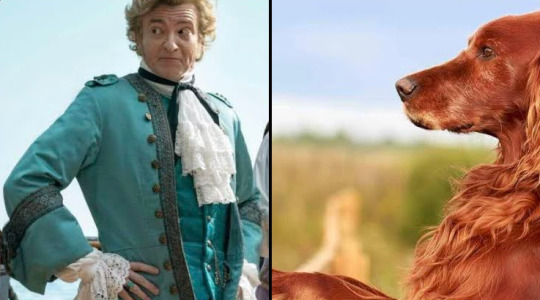
Ed is an Afghan Hound. Elegant as hell. Also doofy.
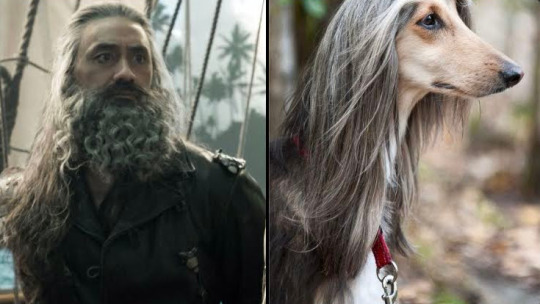
Oluwande is a Yorkshire Terrier. Cute as a button, AND has his shit together.
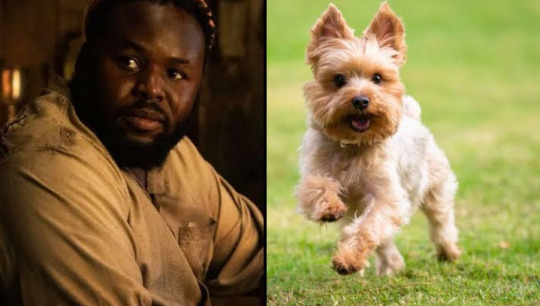
Jim is a Miniature Pinscher. Lil but FIERCE (in all senses).
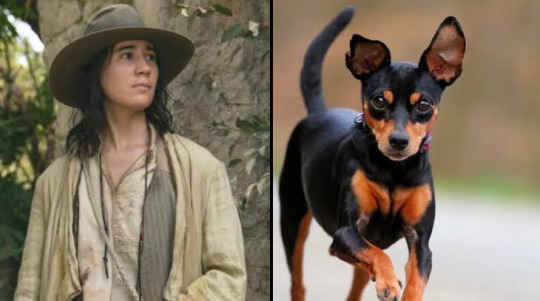
Lucius is a Whippet. Cute yet sleek, relentless sideye.

Pete is a Pug. Wants to seem fierce, actually the cuddliest.

Buttons is an Irish Wolfhound. Rugged, wise, and wild.

Swede is an Australian Terrier. Kooky and sweet.

Frenchie is a Standard Poodle. Suave, smart and weird af.
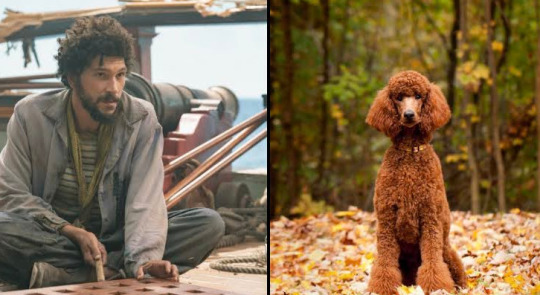
Roach is an Affenpinscher. Fuckin wild, with a heart of gold.
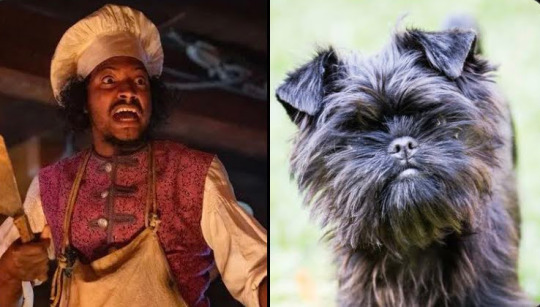
Wee John is a Chow Chow. Because they would both climb into your lap for the best cuddle ever.

Izzy is an Australian Cattle Dog. Grizzled workaholic; needs a snuggle.

Jackie is a Rottweiler. Stylish as hell, bark worse than bite.

Geraldo is a Jack Russell. Just a weird snappy lil guy.
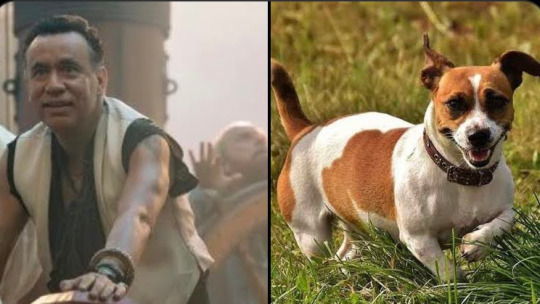
Mary is a Springer Spaniel. Gorgeous and too good for all this.
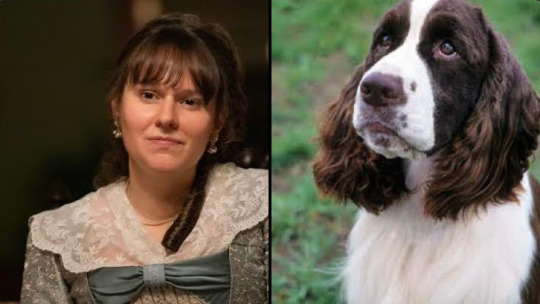
Doug is a Brittany. Just happy to be here.
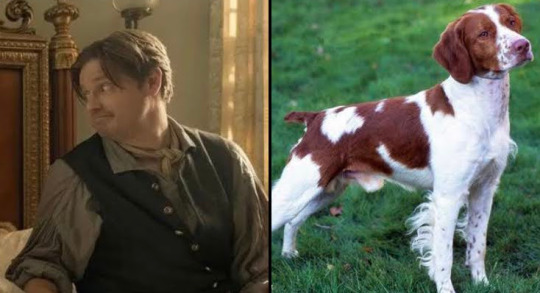
Ivan is a Airedale. Ready at all times - to loot or get a lil snoot boop.

Fang is a Bernese Mountain Dog. Gorgeous and infectiously jolly.

4 notes
·
View notes
Text
The Mini Bernedoodle
Discovering the Delightful Mini Bernedoodle
Welcome to the world of Mini Bernedoodles, a hybrid breed that’s capturing the hearts of dog lovers everywhere. These pint-sized pups are a cross between the Bernese Mountain Dog and the Miniature Poodle, offering the best of both breeds in a smaller, more manageable package.
What is a Mini Bernedoodle?
A Mini Bernedoodle is the perfect blend of the…
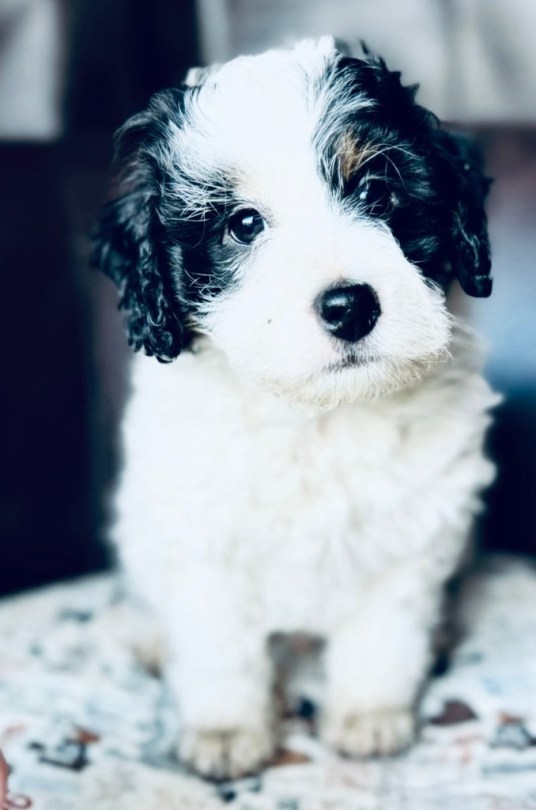
View On WordPress
0 notes
Text
Bernedoodle Dogs: Complete Breed Guide
Is your idea of an ideal pet a gentle, intelligent, trainable dog that can be easily managed? Meet the Bernedoodle. Derived from a cross between the Bernese Mountain Dog and the Poodle — hence, the name — Bernedoodle dogs have become a widely popular and well-loved breed since they arrived on the scene in 2003. And are especially popular on social media.
So, if you’re looking for a canine companion to break the internet with, the Bernedoodle — also known as Bernese Mountain Poos — can be the perfect pick. But more than their adorable faces and lovable demeanor, the defining trait of Bernedoodle dogs is their intelligence. They inherit their intelligence from the Poodle, which is known for its sharp mind.
Sounds like just the dog for you? Let’s take a closer look at Bernedoodle dog personality, temperament, grooming and nutritional requirements, and health issues, along with some other key aspects of Bernedoodle breed info, to make sure you really know what you’re signing up for.
The History of Bernedoodle Dogs
The Bernedoodle is a crossbreed designer dog bred by Sherry Rupke of Swissridge Kennels in Canada in 2003. This was the first recorded instance of the Bernese Mountain Dogs and Poodles being intentionally bred to create a new hybrid dog breed. However, hybrids of these two breeds having accidentally even before this cannot be ruled out.
Considering its novelty and hybrid status, Bernedoodle dogs are not recognized by the American Kennel Club. However, the breed has been recognized by other bodies such as the American Canine Hybrid Club, the Designer Breed Registry, the Designer Dogs Kennel Club, and the International Designer Canine Registry.
Given that these are hybrid dogs, there is no established breed standard either. There are different types of Bernedoodle, and the characteristics and physical attributes of these dogs vary depending on the genetics and bloodlines of the parents and the specifications a breeder is aiming for.
Typically, Bernedoodle types include standard, tiny, and miniature. Of these, the standard variety is the most common. Bernedoodle types are also classified based on their color patterns. On that parameter, Bernedoodle dogs with the tri-color pattern of the Bernese Mountain Dog are the most popular.
Bernedoodle Breed Info
This Bernese Mountain Dog Poodle mix is an adorable small- to medium-sized dog (depending on genetics and breeding specifications). There is quite a variation in the height, weight, and appearance of different types of Bernedoodle dogs:WEIGHTHEIGHTAGE (FULL GROWN)Tiny10-25 pounds15 inches or less9-11 monthsMedium25-55 pounds15-22 inches11-13 monthsStandard55–90 pounds23-27 inches12-16 Months
They have a wavy or curly coat and can be either single or double-coated. There is enough variety in Bernedoodle colors and patterns as well. Their coat can be black, white, tan, blue, rust, red, sable, or silver, and the patterns include tri-color, merle, and piebald. The lifespan of a Bernedoodle is 10 to 12 years.
Everything You Need to Know About Raising A Bernedoodle Dog
While Bernedoodle breed info can offer a lot of insight into the lineage of these dogs, to decide whether it is the right fit for you what you really need to know is what raising and caring for a Bernedoodle entails. What is the Bernedoodle dog personality like? What are their nutritional and activity needs? And what are the common health problems to be aware of in Bernedoodles?
I answer all these questions for you, and then some so that you know precisely what to expect when bringing a Bernedoodle puppy home:
Bernedoodle dog personality and temperament
https://momwithdog.com/wp-content/uploads/2023/12/bernedoodle-types.jpg
Bernedoodle dog personality makes this breed a perfect fit for families. This family-friendly dog is especially fond of children and proves to be a wonderful canine companion. However, it is important to teach kids the right — and safe — way to interact with them (or any dog, for that matter) to avoid any untoward accidents.
They are affectionate and playful and desire a ton of attention and love from their humans. The Bernedoodle dog personality can be best described as:
Goofy
Attention loving
Intelligent
Trainable
Mellow
Loyal
Playful
Friendly
While a Bernedoodle is essentially a teddy bear dog that loves cuddles and quality time with their family, they can be wary of and a little skittish around strangers. As with any other dog breed, it is important to socialize your Bernedoodle early on so that they are comfortable in new settings and around new people. Given that this is a highly trainable dog, molding them into well-mannered pets shouldn’t be hard provided you catch them young and reinforce desirable behaviors consistently.
A standard Bernedoodle is an active dog that requires space to run around and play, so, they thrive in homes with a fenced-in yard. In addition to playing on their own, they also need regular walks or structured play time or both to expend their energy.
If you’re planning to raise a Bernedoodle in an apartment or a home with very little open space, bear in mind that you’ll need to invest extra time and energy in getting your pet their daily dose of exercise and physical activity. Without it, they can start displaying undesirable, often destructive, behaviors like digging, chewing things, and tearing things apart.
Nutrition and feeding
The right nutrition and food vary for different types of Bernedoodle dogs. If you have a standard Bernedoodle, expect them to have a significant appetite whereas the miniature and toy varieties naturally have a lower food requirement. Irrespective of the size and type of your dog, it’s important to offer them a well-balanced, nutrient-rich, high-quality diet, with a special focus on vitamins and minerals that can support their cartilage and joint needs.
While the Bernedoodle is by and large a healthy dog breed, they’re prone to stomach problems and bloating, which is why feeding them smaller, more frequent meals is highly recommended. It’s also important to control portion size and caloric intake to keep them at a healthy weight.
Health concerns
Bernedoodles are considered resilient and healthy dogs. However, even with most mindful and ethical practices of breeding Bernedoodles, they can be prone to certain health concerns, such as:
Hip dysplasia: A common condition in many dog breeds wherein the hip joint is not developed properly, as a result, the socket is too shallow to accommodate the femoral head (ball). This can cause pain and lameness
Elbow dysplasia: A condition similar to hip dysplasia affecting the elbow joint
Bloat: Another common canine health concern wherein the stomach fills with gas and twists, cutting off blood supply. This can prove fatal if not addressed in time
Progressive retinal atrophy (PRA): A degenerative eye condition that can lead to blindness
Cataracts: Clouding of the eye lens, leading to vision problems or loss
Demodex mange: A skin condition caused by mite infestation
Von Willebrand’s disease: A blood clotting disorder
Inflammatory bowel disease (IBD): A chronic inflammation of the digestive tract
Hypothyroidism: A condition caused by an under-functioning thyroid gland, resulting in inadequate hormone production
It’s important to schedule regular checkups and educate yourself about the symptoms of these conditions so that any potential health problems can be detected and addressed early on.
Tips for grooming a Bernedoodle
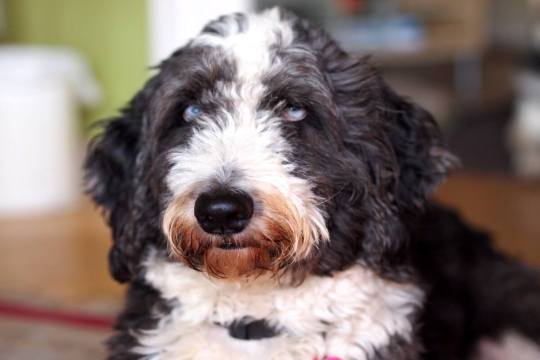
A Bernedoodle is a hypoallergenic, low-shedding dog, which not only makes it an ideal pet for people with allergies but also fairly low maintenance. However, even a non-shedding dog requires regular grooming and care. The coat can be like that of a Poodle or a Bernese Mountain Dog, depending on the standard followed while breeding Bernedoodles. Either way, their coat tends to run wavy or curly, which means it requires regular brushing and also needs to be trimmed every few months.
Bernedoodles love being brushed and groomed by their humans, so brushing their coat daily can be a great bonding experience. In addition to taking care of your dog’s coat, it’s also important to pay attention to their dental hygiene. Offer dental chews or bones at least once a week to prevent tooth decay and bacteria buildup. Their nails need to be trimmed regularly as well to prevent pain and injuries while running or walking.
How to train and socialize a Bernedoodle
This is an extremely sharp breed with a definite streak of stubbornness to them. Likewise, while a Bernedoodle is an affectionate dog, they are known to be wary of strangers and unfamiliar environments. That’s why it’s vital to familiarize yourself with how to train and socialize a Bernedoodle puppy.
Since they’re intelligent dogs, they can learn both good and bad behaviors pretty quickly. That’s why it’s imperative to start training your puppy early on and continue well past puppyhood. These strong-minded dogs respond best to positive reinforcement. The right way to train them is with a lot of treats, love, and appreciation for good behavior. You’d also need to be patient as your puppy learns what’s expected of them and what’s not.
As with training, starting early with socialization is also immensely important for raising a well-adjusted dog. Once your pet’s basic vaccinations are done and the vet clears them to venture outside the home, start exposing them to new people and environments so that they get comfortable with the unexpected.
Training and socialization are also critical for Bernedoodle dogs because they tend to have unique personalities and their behavior, responses, and temperament cannot be as accurately predicted as with a purebred dog. In fact, their response to training can be eager and intense (like that of a poodle) or laid-back and nonchalant (like that of a Bernese Mountain dog).
Is a Bernedoodle right for you?
A playful, loving, loyal dog, a Bernedoodle makes for an ideal pet for families, especially those with younger children since these dogs adore kids. They may not, however, be well-suited for environments where they’re required to spend a lot of time alone daily given that they thrive on love and attention from their humans. So, if you’re a single person or a small family where every member goes out to work or study, a Bernedoodle may not be the right fit for you.
Ref:- https://momwithdog.com/bernedoodle-dogs/
0 notes
Text
<h1>On-line Pet Boutique Buy Dog Supplies, Designer Pet</h1>
Please obtain an application from our web site to start this adoption process. Our approval course of is finished as quickly as potential by our Placement Team. You can also safe an adoption application by requesting it from our e-mail handle which is if you have any hassle with the download.
Our site is filled with info and selections, making it straightforward for you.
Keeping training classes enjoyable will keep his brain engaged long enough to learn the fundamental instructions.
The SRC Placement Team takes satisfaction in having the power to process applications rapidly.
They are registered as Wheaten via AKC and typically have brown or hazel eyes.
When you are accredited as as adopter, we will be joyful to arrange meetings with any of our rescues.
Dusky is an attractive woman who is studying all concerning the fun in life, walks beautifully on a lead and would love a home together with her greatest pal Alie if ...
Upon adoption, will in all probability be your responsibility to rearrange to pick up your new household good friend.
Very cussed boy however we love him a lot. He gets consideration all day long and very joyful about it. Lots of exercise every single day and play with our children who adore him.
Bernese Mountain Canine
The canine's micro-chip might be registered in your name(s) by SRC at no cost. Once the foster father or mother has reviewed your info, they'll answer your questions. You may have a meet and greet with the dog chosen if desired. The SRC Placement Team takes satisfaction in with the power to course of applications shortly. That is what units our organization apart from many others. We really feel that stable applicants deserve a fast turnaround time, and we make every effort to expedite the processing of functions inside purpose.
How Much Does A Miniature Schnauzer Cost? 2023 Worth Guide
You additionally need to play to his strengths, which is vitality. Keeping training periods fun will maintain his mind engaged long sufficient to learn the essential commands. If you enable him to get away with naughty behaviors, he would possibly turn out to be an boastful and grumpy lil’ man.
Breed Club Actions Embody:
His intelligence and stubbornness together make him a tough dog for a first-time dog owner. He may additionally be a bit of a grumpy-butt if he doesn’t get his own method. Hepper.com does not intend to provide veterinary recommendation. While we provide data assets and canine schooling, the content right here isn't an various to veterinary steerage. There’s no avoiding the one-time prices, and even the monthly expenses if you’re looking to own a Miniature Schnauzer. Budget for each single merchandise on this record, and you’ll never find yourself in a monetary bind.
Miniature Schnauzer Puppies For Sale
Dorris Day and 50 cent are just a few celebrities who have fallen head over heels with this breed. My name is Smoky and I went to live in North Mankato MN with my new family in November of 2018. I am happy, wholesome and really playful pet. Boss Dog, a Havachon, came to our home in March as Covid 19 began! 🤭 He was potty skilled because of being crate trained!!
Discover Puppies On The Market Near Me
After a week in our home, he undoubtedly knew that Potty was for out of doors. Our vet stated that he is wholesome (I can’t assure nothing will come up genetically, however up to now so good). Most of our dogs reside in loving foster properties, till they find their excellent eternally residence. Others spend time in a veterinary clinic for therapy, if wanted, and a few could additionally be kept in boarding where they'll get coaching as a outcome of social issues. They might come to us from shelters, from the streets, from puppy mills or from owners who can not, or is not going to, take care of them any longer. In almost all instances, a minimum of in their current previous, they haven't felt the security of a loving house.
Mini Schnauzer Puppies
With all that Schnauzer swag packed into his little body, he is sufficient to maintain essentially the most lively households on their toes. He’s cute, however he's feisty and independent. If you’re looking for a family protector that doesn’t require an extreme amount of room, this pup could possibly be the canine for you.
Beautifulminiature Schnauzer Pups
We got her August 2019, and she or he could be very lovable! She love to snuggle, very protecting and positively love people! We obtained Milo from you again in August, he just turned 1 April 1st and is such an unimaginable celebration of our household. He shall be 2 on January 14th he is the best and smartest pup we now have ever had. Rolls over, shakes, rings a bell to go outside!
Settling In Your New Dog
Even when you assume you understand about Schnauzers, it’s important to keep in mind that every dog has their own persona. Before you give any type of Miniature Schnauzer or Schnauzer a home, it’s essential to find out about potential health points. Remember, not every dog will undergo them but it’s good to be prepared. Every dog is totally different with their very own personality and wishes.
Miniature Schnauzer-standard
Adopt a canine from a good Rescue Organization and you'll have a pal for all times. Your friend will already be vetted and evaluated for his or her demeanor so that their demeanor will extra closely match your personality traits. SRC stands behind our canines; and if essential, your adopted dog could additionally be returned to us per your adoption contract.
Leaving you no excuse to leave him behind! He is a robust-looking canine who is an athletic and powerful pup beneath all that hair of his. Most canines have a proportionate look and resembling their standard-sized cousin. This breed is jam-packed full of persona. He likes to think of himself because the household protector, and he'll stand up to the meanest of bullies. Schnauzer near me for Sale don’t stand an opportunity with this dog round, so if you are looking for a household protector and guard dog, this could probably be the canine for you.
This Map Exhibits What Number Of Schnauzer Canines Are Posted In Other States
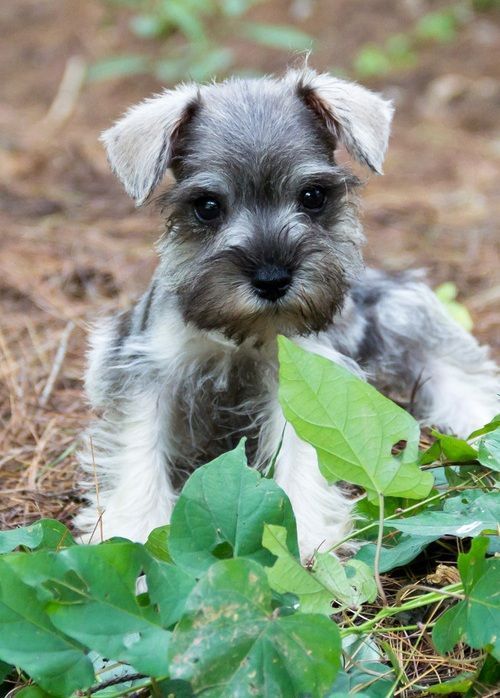
Most salt and peppers will become a beautiful silver shade and so some people mistakenly will name them a “Silver”. If you might be paying more for a SILVER, you are being taken advantage of….silver is solely the color that every one salt and peppers mature to be. Black Gold's Maximus Artimus aka Maximus or Max is our brilliant black & silver AKC registered Miniature Schnauzer male. This flashy boy comes from an AKC Grand Champion pedigree. Although Max's looks are daring & striking & his pedigree perfect, it’s his temperament & personality that sets him aside. He’s perceptive, fantastic with kids (babies to adults), compliant and eminently calm.
But for some purpose, breed fanciers prefer the darker and more traditional Schnauzer shades. The Mini Schnauzer is a toy to small-sized canine breed, and he weighs between eleven and 20 kilos. At 12 to 14 inches, he is sufficiently small to suit into your purse.

Schnauzer Rescue Cincinnati
Wheatens can have brown or black pads, and a brown or black nostril. The blacks are precisely what they sound like…solid black. They are born black, they are black as juveniles, and they want to stay black. Some blacks will start to lighten to a darkish grey as they age, however who doesn’t turn slightly grey with age?! Some blacks are in a position to retain their deep black color throughout their lives.
youtube
#Schnauzer near me for Sale#mini schnauzer puppies for sale#schnauser puppies for sale#Miniature Schnauzer Puppies for Sale#Miniature Schnauzer Puppies for Sale 700#Miniature schnauzer near me for sale#Schnauzer near me for sale under $500#Schnauzer for Sale#Schnauzer for Sale near me#miniature schnauzer puppies for sale $700#miniature schnauzer for sale#mini schnauzer for sale#for sale schnauzer puppies#Toy Schnauzer for Sale
1 note
·
View note
Text
Choosing the Right Doodle Dog Breed for Your Lifestyle
When it comes to choosing a canine companion, Doodle dog breeds have gained immense popularity in recent years. Their endearing personalities, charming looks, and hypoallergenic qualities make them an attractive choice for many pet lovers. However, selecting the right golden doodle. Want a Doodle of your choice visit Merle Goldendoodle For Sale
Understanding Doodle Dog Breeds: Doodle dogs are a diverse group of mixed-breed canines resulting from the crossbreeding of Poodles with various other breeds like Labrador Retrievers, Golden Retrievers, Bernese Mountain Dogs, and more. Each Doodle breed inherits a unique set of traits from its parent breeds, which directly impacts their suitability for different lifestyles.
Size Matters: Doodle dog breeds come in various sizes, ranging from tiny Miniature Doodles to larger Standard Doodles. Consider the space you have at home and your ability to accommodate a dog of a particular size. Smaller Doodles are ideal for apartment living, while larger ones may require more space to roam.
Activity Level: Different Doodle breeds exhibit varying activity levels. Some are highly energetic and require extensive daily exercise, while others are more laid-back. Assess your activity level and commitment to exercise. If you're an active person, a high-energy Doodle like the Labradoodle might be a great fit. Conversely, a lower-energy Doodle like the Goldendoodle could be better for a more relaxed lifestyle
Temperament and Personality: Doodle dogs generally have friendly and affectionate personalities. Still, there can be differences in temperament between breeds. Research the breed's typical temperament traits to ensure they align with your expectations and lifestyle.
Want to buy Miniature Golden Doodles visit Miniature Golden Doodles For Sale
In conclusion, choosing the right Doodle dog breed for your lifestyle involves thoughtful consideration of factors like size, activity level, allergies, temperament, training, health, grooming, and socialization needs.
0 notes
Text
Bernedoodle Puppies & 9 Facts You May Want To Know
A glance at Bernedoodle Puppies
Bernedoodle puppies are a popular designer dog breed that combines characteristics of the Bernese Mountain Dog and the Poodle. These puppies have grown in popularity due to their cute and fluffy appearance, as well as the fact that their fur does not cause allergies. Dogs captivate people all over the world because they make excellent family pets and friends.
History
Where the breed originated
The Bernese Mountain Dog and the Poodle were purposefully bred together in the early 2000s to create the Bernedoodle breed. The goal was to create a dog that possessed the best characteristics of both parent breeds, such as the Bernese Mountain Dog's loyalty and the Poodle's intelligence and allergy-free coat. The breed became well-known and popular due to how adorable it looked and how well it behaved.
What distinguishes Bernedoodle Puppies from other Bernedoodle breeds?
A Bernedoodle is typically the result of a cross between a Bernese Mountain Dog and a Poodle. However, there are some distinctions between dogs of the same breed. The various generations, such as F1, F1b, F2, and so on, demonstrate the level of hybridization and genetic makeup. Each generation may have different traits and coat types depending on how the parents mated.
Characteristics
External appearance
Poodle and Bernese Mountain Dog physical characteristics are shared by Bernedoodle puppies. They typically have a wavy or curly coat that sheds little and is often hypoallergenic, allowing allergy sufferers to live with them. They can look different from generation to generation and from parent breed to parent breed. They are usually strong, have eyes that show a lot of emotion, and appear friendly and easy to talk to.
Character traits
Bernedoodle puppies are said to be friendly, loving, and good with people. Most of the time, they get the Bernese Mountain Dog's gentle, loyal personality as well as the Poodle's intelligence and trainability. They are said to be very adaptable, good with families and children, and eager to please their owners. They enjoy being around people and spending time with their family.
Temperament
Bernedoodle puppies are calm and even-tempered, making them an excellent choice for families and individuals looking for a dog to keep them company. They are usually good with children because they are patient and kind. Socializing them when they are young helps them grow into well-adjusted, friendly dogs who are at ease in a variety of settings and with a variety of people and animals.
Size, weight, and life expectancy
Bernedoodle puppies can be different sizes, weigh different amounts, and live different amounts of time depending on the breeder and generation of the cross. They can range in size from extremely small to average. Miniature Bernedoodles typically weigh between 11 and 22 kilograms (25 to 50 pounds), while standard Bernedoodles can weigh up to 32 kilograms (70 to 90 pounds). Their average life span is between 12 and 15 years, but this varies by individual.
People education and training
Early education and socialization are critical.
If you want your Bernedoodle puppy to grow up to be a well-behaved, well-adjusted adult dog, you must train and socialize it while it is still a puppy. Training them when they are young helps them develop good habits, learn basic commands, and get along with people and other animals. They should go to different places, see different things, hear different sounds, and do different things during socialization. This will help them grow up to be confident and well-rounded individuals.
Suggestions for training methods
When training Bernedoodle puppies, positive reinforcement works well. They are intelligent and eager to please, which allows them to learn quickly. Reward-based training is extremely effective. This is when you use treats, praise, and play to elicit the desired behavior. Training sessions are most effective when there is consistency, patience, and gentle direction. You can also help them learn and socialize with other dogs by enrolling them in puppy classes or hiring professional trainers.
Problems with people's behavior and how to solve them
Bernedoodle puppies frequently exhibit behaviors such as biting, jumping, and excessive barking. To stop them from chewing, you can give them chew toys or divert their attention to something else. Jumping can be stopped with consistent training and positive reinforcement methods. You can stop your dog from barking excessively by training him, determining what motivates him, and treating any underlying causes, such as boredom or anxiety.
Taking care of business
Common diseases and symptoms: Bernedoodle puppies are susceptible to the same health issues as Bernese Mountain Dogs and Poodles. Hip dysplasia, elbow dysplasia, eye problems, and some genetic conditions are among the most common health issues. Regular vet visits, a balanced diet, exercise, and proper grooming are all essential for maintaining their health and detecting any problems early.
Dietary requirements
The food requirements of a Bernedoodle puppy vary depending on its age, size, and activity level. It is advised that you feed them high-quality dog food formulated for their size and age. It's critical to monitor their weight and adjust their food portions accordingly so they don't gain weight and their health remains optimal.
Exercise necessities
Bernedoodle puppies require physical and mental stimulation by playing and running around. They get the exercise they require through daily walks, playtime, and cooperative games. However, you must consider their size and energy level to ensure that they do not become overtired. Training and puzzle toys can also be beneficial to their overall health.
Personal hygiene and grooming
Bernedoodle puppies' coats must be brushed frequently to keep them in good condition and from becoming matted. Long-haired dogs may require brushing more than once a week to remove loose hair and keep it from becoming tangled or matted. A professional groomer may be required to make their coat look nice. It is also necessary to clean and trim their ears, teeth, and nails as needed.
Having children and reproducing
When breeding Bernedoodle puppies, their health and happiness should come first. Responsible breeders ensure that their breeding dogs receive the necessary health checks so that they do not pass on genetic health problems. They ensure that the puppies are well cared for and that their breeding dogs have all of the necessary health clearances. It is critical to conduct research and find reputable breeders who are concerned about their dogs' health and behavior.
Where can I get and buy an animal?
If you want to buy or adopt a Bernedoodle puppy, you should do a lot of research and choose a reputable source. Reputable breeders are concerned about their dogs' overall health, behavior, and well-being. They look after their breeding dogs, teach them how to get along with other people, and monitor their health. The best thing to do is visit the breeder's facility, meet the puppies' parents if possible, and ask questions about how they breed, how they test for health, and how they care for the puppies in general.
It may be easier to find Bernedoodle puppies with the help of online platforms and websites that connect people looking to buy puppies with reputable breeders. However, you should exercise caution and thoroughly investigate any online sources before purchasing anything from them. Look for breeders who have positive reviews, are open about how they raise their dogs, and are concerned about their dogs' health and happiness.
You could also consider getting a Bernedoodle puppy from a shelter or rescue organization. Many organizations assist mixed-breed dogs, such as Bernedoodles, in regaining their health so that they can be adopted by a caring family. Contact local rescue groups, animal shelters, or breed-specific rescue groups to see if Bernedoodle puppies are available for adoption.
In popular culture, Bernedoodle Puppies
The well-known Bernedoodle
Although some Bernedoodle puppies are not well-known on their own, the breed as a whole has grown in popularity and has been featured in a variety of media outlets. They are frequently seen in social media posts, websites, and online groups about adorable and charming dog breeds. Bernedoodles are popular among dog lovers all over the world.

Bernedoodle Puppies have appeared in films and television shows.
Bernedoodle puppies and dogs in general have been used to make them look cute in movies, TV shows, and commercials. Because of how they look, how friendly they are, and how charming they are, they are ideal for movie roles that require a friendly and photogenic dog.
How the breed is portrayed in the media
Bernedoodles have grown in popularity due to their appealing appearance and temperament. They've been featured in a variety of media outlets. They can be found in books, calendars, and other dog-related items. Furthermore, because they are popular on social media sites, they are frequently featured in online articles, photos, and videos that highlight their cuteness and appeal.
Conclusion
In conclusion, Bernedoodle puppies are a popular and sought-after breed known for their adorable appearance, friendly personalities, and allergy-friendly coats. They were created through the crossbreeding of Bernese Mountain Dogs and Poodles. They have the best characteristics of both of their parents. Bernedoodles make excellent family pets and companions because they are devoted, intelligent, and adaptable.
You should train and socialize your Bernedoodle puppy as soon as possible if you want it to grow up to be a well-behaved, well-adjusted dog. To ensure that training sessions go smoothly, use positive reinforcement, remain consistent, and be patient. It is critical for their overall health to teach them how to deal with common behavioral issues and to keep their minds and bodies active.
Regular vet visits, a balanced diet, exercise, and brushing are all essential components of care and maintenance. It is critical to monitor their health and address any issues as soon as possible. When breeding Bernedoodle puppies responsibly, the puppies' health and happiness come first. Find reputable breeders or consider adopting a pet from a rescue organization.
Although few people are aware of individual Bernedoodle puppies, the breed as a whole has grown in popularity and has been featured in popular culture. They are popular pets and are frequently praised in the media due to their cuteness and friendliness.
Choosing a Bernedoodle puppy is a thrilling experience. You can find a great friend who will bring you joy and love if you do your research and give it some thought.
0 notes
Text
Discover How Weighted Jackets for Dogs Can Help Get Fit A Complete Guide

Meta Description
Find out how your dog's exercise regimen might be changed using weighted jackets. Discover the best practices for choosing, introducing, and combining weighted jackets for dog performance and health.
Exploring the Weighted Jackets for Dog Fitness
Weighted jackets are an original method that the dog fitness industry is now improving the physical fitness and general health of dogs. These specialty clothes are intended to provide focused friction during exercise, which successfully turns ordinary activities into active exercises.
They are much more than simply a statement of style. The use of weighted jackets has become an effective means for reaching measurable fitness objectives as dog owners look for methods to maximize the workouts of their animal friends.
Understanding the potential advantages of weighted jackets for our dog friends requires an understanding of the science behind them. Through an examination of how these jackets affect dog biology, including muscular growth, improved endurance, and heart function, we may better understand their usefulness as instruments for boosting peak fitness.
Furthermore, by using appropriate security measures and progressive introduction methods, dogs may benefit from weighted jacket education without jeopardizing their well-being.
The Weighted Jacket for Dogs Scientific Basis
Heavy dog jackets are made with extensive knowledge of pup biology. These specialty clothes have a function based on the laws of physics; they are more than just clothes to wear. We can understand how weighted jackets affect a dog's biology and how they might improve general health and fitness in dogs by learning more about these systems.
Effect on the Biology of Dogs
When a dog moves, weighted jackets provide a regulated amount of pressure to their body, causing different biological responses.
Muscle Construction
As the dog rotates, the extra weight these jackets give causes a greater level of muscle involvement across various muscle groups. Increased muscle activity serves as a kind of workout that is similar to what is seen in sports. Increased muscular growth, power, and tone may result from this over time.
Bone Size
Weighted jackets may benefit bone health in addition to muscular growth. More weight on the bones promotes development and reshaping especially in weight-bearing bones.
This feature is especially helpful for puppies going through the developing period or for seniors who want to maintain the strength of their bones and avoid age-related problems like bone loss.
Attitude and Body Knowledge
Dogs with weighted jackets often have a better awareness of themselves and their attitude. They have to modify their center of pressure and balance due to the additional weight, which improves their sense of balance and awareness of space.
This feature is especially helpful for dogs with bone issues or those undertaking rehabilitation from injury since it promotes regular exercise and lowers the chance of falls or other accidents.
Impacts on Performance and Muscle Growth
Muscle Stimulating
Compared to standard exercise alone, the effort offered by weighted jackets boosts a wider variety of muscles. By fostering a more balanced muscle, this complete engagement lowers the chance of problems that may result in injuries or incorrect movement.
Furthermore, regular muscle activation across the body enhances general strength and practical movement behaviors.
Improvement of Durability
Dogs' ability to endure often becomes better as they get used to the extra weight of the jacket. Exercise increases the burden on the circulatory system and muscle tissue, which leads to this improvement in durability. Dogs are better at using oxygen and energy as they age, which enables them to engage in exercise for extended periods without becoming tired.
Benefits for the Metabolic System
Exercises involving increased resistance, such as wearing weighted jackets, might cause changes in metabolism. Exercise may cause dogs to burn more calories, which helps them maintain a healthy weight and metabolism.
Furthermore, increases in insulin tolerance and glucose management may result from the increased metabolic effort experienced during weighted exercise sessions, which may lower the risk of metabolic illnesses like diabetes.
Knowing these complex biological effects makes it clear why weighted jackets are a recommended addition to dog exercise programs. But it's important to utilize them carefully, taking into account the unique qualities of each dog, such as age, species, and general health.
Seeking advice from medical professionals may be very helpful in making sure that weighted jacket teaching is secure and advantageous for every individual dog partner.
Selecting the Ideal Weighted Jacket
It's important to take into account several requirements while choosing the right weighted jacket for your pet. Not all weighted jackets are made equal, and selecting the ideal one requires weighing several factors to guarantee both effectiveness and safety while in use. Here's a detailed look at the things to think about before getting your pet a weighted jacket:
Things to Think About Before Buying
Weight Spread
Your dog's safety and well-being are greatly dependent on how the jacket distributes its weight. Seek for coats that disperse the extra weight across the entire body instead of putting it all in one place.
Uneven distribution of weight may cause pain, strain on muscles, or even damage, especially when wearing something for a long time or performing severe activities.
Flexibility
Choose a weighted jacket that is flexible and can be adjusted for both fit and burden. This lets you adjust the force to suit your dog's demands, level of health, and training objectives.
As your dog becomes stronger, you may alter the degree of the training by adding or removing weight packs from the jacket or adjusting the straps.
Component Excellence
Evaluate the jacket's building materials' quality. Strong, breathable materials are necessary for enduring constant use and allow for proper ventilation while working out. Should you want to use the jacket in environments where dealing with moisture is a problem, look for fabrics that are fast to dry or water-resistant.
Take into account how simple it is to clean and maintain the jacket as well to make sure it stays odor-free and safe over time.
Safety Features
To improve awareness and reduce hazards while engaging in outdoor activities, give priority to jackets with safety features. Low-light visibility is improved with shining strips or high-visibility voices, which lowers the risk of crashes or errors. When engaging in intense motion, secure fasteners like hook-and-loop fasteners or flexible belts keep the jacket from sliding or falling loose.
Connectivity with Straps and Leads
Verify that the weighted jacket is appropriate with the straps and straps you already own if your dog uses them for walks or training sessions. To ensure easy integration without sacrificing comfort or utility, look for coats with incorporated leash connection points or harness-compatible patterns.
Challenges for Size and Comfort
Proper Evaluation
To get the right jacket size, take precise measures of the dog's physical dimensions. Calculate the neck diameter, the distance from the lowest point of the head to the tip of the hair, and the length around the upper body to ensure a proper fit.
It is advisable to avoid making selections based just on weight divisions since dogs of the same weight might have different body forms and measurements.
Comfort and Flexibility of Motion
When choosing a weighted jacket, give special consideration to feel and range of motion. Make sure the garment fits your dog comfortably and properly without limiting its range of motion. Focus on important regions like the abdomen, chest, and shoulders where pleasure and maximum performance depend on being able to move.
Sample Adapting
Before investing, wherever feasible, let your dog test on the weighted jacket. This enables you to personally evaluate the fit and level of ease and make the necessary changes. When your dog wears the jacket, pay attention to how they move and behave to make sure there are no symptoms of pain or limitations.
Through careful consideration of these variables and thoughtful selection of the ideal weighted jacket, you can optimize your dog's training experiences and successfully promote their fitness objectives. To make sure that you and your dog have a good and happy time, keep in mind to put security, pleasure, and usefulness first.
Rules for Wearing Weighted Jackets in a Safe Way
Although there are many advantages to using weighted jackets for your dog's training and fitness, it is crucial to make sure they are safe while wearing them. Following the necessary security measures not only shields your dog from any danger but also optimizes the success of their training program. An extended look at safety factors for wearing weighted jackets is provided below:
Appropriate Distribution of Weights
Equal Load Delivery
Make sure your dog's body receives the additional weight from the weighted jacket in a fair way. An equal load distribution reduces the chance of strain or damage to certain joints or groups of muscles. In addition to encouraging typical motion patterns, this healthy distribution lessens the chance of pain or fatigue.
Ideal Weight Picking
Considering your dog's size, species, age, and level of fitness, choose a weighted jacket with an acceptable weight level. Gently increase the weight as your dog turns used to wearing the jacket; start with one that is thinner. Don't go beyond advised weight limitations to save your dog's skeletal system from excess stress.
Customized Weight Selections
Select a weighted jacket that lets you adjust the amount and location of the weight. You may customize the durability of a jacket to meet the individual demands and training objectives of your dog by adding or removing weight packs or adjusting sections. This flexibility guarantees that the exercise your dog gets is safe and appropriate for their level of ability.
Meeting with an Expert
When choosing a weighted jacket for your dog, get advice from an authorized vet or professional pet fitness trainer. These experts may provide specific guidance depending on the special qualities of your dog and any deeper medical problems.
Speaking with professionals guarantees that, to protect your dog's health, you make well-informed choices on weight choosing and use.
Observing Measures of Fear or Exhaustion
Watchful Evaluation
While your dog is wearing the weighted jacket, pay special attention to their actions and body language. Keep an eye out for any indications of anxiety, such as hunger, heavy panting, or anxiety, since these could mean that the weight level is too difficult or that the jacket is making you uncomfortable.
Subtle Indicators
During exercise sessions pay attention to any slight shifts in your dog's position, stride, or overall attitude. Fatigue symptoms, such as falling behind, not wanting to go on, or losing interest, should be addressed right once and may call for a change in the training plan or a break.
Reaction to Touch
Your dog's sense of security and any areas of stress or pain may be noticed by gently feeling their joints and muscles. Examine how your dog reacts to touch and take note of any sensitive or uncomfortable behaviors that can point to strain or overwork.
Clear communication
Clear communication is essential to determining your dog's sense of security and readiness to continue learning. Make sure you are communicating with the animal. Encourage your dog to use loud signals, such as "easy" or "slowly down," to indicate when it's time to take pauses or lighten up on activity.
To protect your dog's safety and well-being, fast respond to their indications and modify the program as necessary.
Resting and Healing
Give yourself plenty of time to relax and recover in between weighted jacket workouts. By allowing your dog's tissues to heal and adjust to the increased activity, proper sleep intervals reduce the likelihood of stress problems, muscular strain, and feeling tired.
To encourage the best possible healing and avoid compound fatigue include rest days in your dog's training program.
A safe and joyful training session may be guaranteed by following these extensive safety instructions and paying great attention to your dog's reaction while wearing a balanced jacket.
Put your dog's support, health, and longevity first to get the most out of weighted jacket education. While lowering the possibility of pain or damage. Keep in mind that getting the results you want and building. A solid relationship with your dog partner needs patience. Tenacity, and careful attention to detail.
How to Give a Weighted Jacket to Your Pet
Teaching your dog to a weighted jacket is a long process that takes patience. Encouragement, and careful consideration of your dog's health and flexibility. Your dog may get used to wearing the jacket with ease and confidence. If you use training methods that focus. On encouragement and progressive introduction.
Techniques for Gradual Overview
Knowledge of the Jacket
Start by letting your dog grow comfortable wearing the weighted jacket in a comfortable, stress-free environment. Place the outerwear near your dog's blanket or favorite resting location. Enabling them to inspect and smell it during their time off. To help you form pleasant connections with the jacket, give it some treats and attention.
Brief Wear Periods
Begin with brief, monitored wear periods of the weighted jacket, increasing the length over time. Initially, simply put the coat on for the dog for a few seconds at a time to avoid upsetting them. Take advantage of these quick sessions to see how comfortable. Your dog is wearing the jacket and how they react to it.
Attractive Organizations
To encourage the desired behavior, link wearing the jacket to enjoyable events and incentives. When your pet wears the jacket, give them food, praise in words, or their favorite toys. To help them form a good relationship with the item. When sporting the jacket, your dog will feel more at ease and self-assured thanks to this beneficial reinforcement.
Progressive Weight Furthermore
When your dog is satisfied wearing the jacket for a long time, gradually add weights to the garment in stages. Start with lesser weight packets or fewer weights, then raise the effort. As your dog grows adjusted to the increased burden. Keep a careful eye on your dog's reaction and modify the weight level as necessary.
Exposure Training
Use reduction methods to make your dog accustomed to the feeling of wearing a heavy jacket. Carefully touch and touch various sections of the coat, gradually adding the feeling of weight and stress. Pair these encounters with prizes and praise to build a favorable connection with the jacket's feel.
Effective Reinforcement Teaching Methods
Reward-Based Learning
To get your dog to put on the heavy jacket voluntarily, use reward-based methods for training. Offer sweets, praise, or favorite things as rewards for using the jacket and showing calm, friendly conduct. Rewarding behavior encourages your dog to participate gladly in the desired activity.
Implement Clicker
Implement clicker methods of training for enhancing the good behaviors connected to donning the weighted jacket. When a desired behavior like sitting or standing still while wearing the jacket. Marked with a clicker, it can be rewarded with a reward.
Using the clicker consistently aids in behavioral change and learning by letting your dog know which actions are rewarding.
Gradual Lighting
Slowly subject your dog to sporting the weighted jacket in different circumstances and during varied activities. Once you've mastered low-stress situations like wearing the jacket inside. During quiet times you can move on to more challenging settings and activities. Regular use allows your dog to develop trust as well as relax while wearing the jacket in different situations.
Tolerance and Uniformity
Show patience as your dog makes improvements and remain steady in your training methods. It took time for City to be created, and the same is true. For your dog's transition to a weighted jacket. Celebrate little successes and development goals. Prepare to change your training techniques. Required to meet your dog's specific requirements and preferences.
Terminate with a Positive Note
Despite the result, always conclude training sessions with an upbeat mood. Take off the jacket and give your dog love and reward if they show indications of stress or pain. Ending on a good note helps sustain your dog's excitement and drive for future exercises.
Your dog can learn to wear a weighted jacket with ease and trust if you use methods of instruction. That involves gradual introductions and encouragement to succeed.
Throughout the training phase, keep in mind to be cautious, consistent, and aware of your dog's needs. You should also celebrate each progress your dog makes toward greater health and fitness.
Conclusion
As the study of weighted jackets for dog fitness comes to an end. These cutting-edge devices have huge potential. To improve our dogs' physical health. We've explored the research behind weighted jackets in this thorough guide. To learn more about their effects on heart health, muscular growth, and strength. Through the order of appropriate selection, growing introduction methods. And inclusion into exercise regimens, we have prepared ourselves. With the information and resources necessary. To optimize the advantages of weighted jackets for our animal friends.
The adaptability of weighted jackets provides plenty of opportunities for enhancing our dogs' fitness activities. From strengthening and conditioning to enhancing heart function. Weighted jackets offer an active edge to ordinary activities, turning them into planned exercises.
Whether you're walking rapidly, training speed, or enjoying the great outdoors. By providing our dogs with constant training, encouragement, and careful attention. We may enable them to achieve incredible levels of wellness and energy.
During their fitness journey, we as trustworthy dog owners must always put our dogs' ease, security, and unique requirements first. We can make sure that our dogs' health adventures are not only successful but also pleasurable and fulfilling. By continuing to pay attention to appropriate weight delivery, and keeping an eye out for symptoms. Of exhaustion or pain, and creating a good training experience.
FAQs
What are dog-weighted coats and exactly how do they function?
Dogs wearing weighted jackets experience opposition throughout their activities, which improves muscular activation and the efficiency of their workouts.
What are the advantages of giving dogs weighted jackets?
They help control weight and enhance cardiac wellness, muscular strength, and durability.
Are all dogs suited for wearing weighted coats?
Not every time. Before using, particularly for pups, senior dogs, or dogs having health concerns, see the doctor.
How do You introduce wearing a heavy jacket to my dog?
Introduce the jacket slowly by giving it small wear intervals and rewards, then gradually boost its weight and length.
#Bernese Mountain Dog#bernese australian shepherd mix#bernese mountain dog puppies#bernese poodle mix#Petinfosite#lebanese dog#gentle giants dog food#mini bernese mountain dogs#full grown mini bernedoodle#bernese mountain dog poodle mix#bernese mountain dog golden retriever mix#bernese mountain dog rescue#when to stop fighting mast cell tumors in dog#mini bernedoodle full grown#miniature bernese mountain dog#pictures of mast cell tumors in dogs#bernese mountain dog mix#bernese mountain dog life expectancy#do bernese mountain dogs shed#bernese mountain dog poodle#bernese mountain dog and golden retriever mix#rescue a bernese mountain dog#bernese mountain mix poodle#how big do bernedoodles get#bernese mountain dog shedding
0 notes
Text
Bernedoodle Puppies & 9 Facts You May Want To Know
Look at Bernedoodle Puppies quickly.
Bernedoodle puppies are a popular and sought-after designer dog breed that combines the characteristics of the Bernese Mountain Dog and the Poodle. People love these puppies because they are cute and fluffy, and their fur doesn't bother people with allergies. Dogs are great family pets and friends, so people all over the world often fall in love with them.
The past
From where the breed came
The Bernedoodle breed was made when the Bernese Mountain Dog and the Poodle were bred together on purpose in the early 2000s. The goal was to make a dog with the best qualities of both parent breeds, like the loyalty of the Bernese Mountain Dog and the intelligence and allergy-free coat of the Poodle. The breed became well-known and popular because of how cute it looked and how well it behaved.
What makes Bernedoodle Puppies different from other Bernedoodle breeds?
Most of the time, a Bernedoodle is the child of a Bernese Mountain Dog and a Poodle. But even dogs of the same breed can be different in some ways. The different generations, like F1, F1b, F2, and so on, show the level of hybridization and genetic makeup. Depending on how the parents got together, each generation may have different traits and coat types.
Things that make up
From the outside
Both the Poodle and the Bernese Mountain Dog can be seen in the appearance of a Bernedoodle puppy. They usually have a curly or wavy coat that sheds little and is often hypoallergenic, so people with allergies can live with them. From one generation to the next and from one breed of parent to the next, they can look different. Most of the time, they are strong, have eyes that show a lot of feeling, and look friendly and easy to talk to.
Qualities of a person
People say that Bernedoodle puppies are good with people, friendly, and loving. Most of the time, they get the gentle, loyal nature of the Bernese Mountain Dog and the intelligence and trainability of the Poodle. People say that they are very flexible, good with families and kids, and eager to please their owners. They like to be around other people and do things with their family.
How people act
Bernedoodle puppies are calm and even-tempered, so they are a good choice for families and people who want a dog to keep them company. Most of the time, they are good with kids because they are nice and patient. Socializing them when they are young helps them become well-adjusted, friendly dogs who are comfortable in different places and with different people and animals.
How big, how heavy, and how long it lives
Bernedoodle puppies can be different sizes, weights, and live different lengths of time depending on the breeder and the generation of the cross. They can be very small or average-sized. Standard Bernedoodles can weigh anywhere from 32 to 41 kilograms (70 to 90 pounds) or more, while miniature Bernedoodles usually weigh between 11 and 22 kilograms (25 to 50 pounds). Their average life span is between 12 and 15 years, but this can vary from person to person.
learning about people and getting training
Training and getting to know people early on are very important.
It's important to train and socialize your Bernedoodle puppy when it's young if you want it to grow up to be a well-behaved, well-adjusted adult dog. When they are young, training helps them get into good habits, learn basic commands, and get along well with people and other animals. During socialization, they should go places, see things, hear sounds, and do things that are different from each other. This will help them become confident and well-rounded adults.
Some ways to train are suggested.
When Bernedoodle puppies are being trained, positive reinforcement works well. They are smart and eager to please, which helps them learn quickly. Reward-based training is a very good way to teach. This is when you use treats, praise, and playtime to get the behavior you want. Training sessions work best when there is consistency, time, and gentle direction. Sending them to puppy classes or having them work with professional trainers can also help them learn and get along with other dogs.
People's bad habits and how to fix them
Problems like biting, jumping, and too much barking are common in Bernedoodle puppies. To stop them from chewing, you can give them something to chew on or try to get their attention on something else. Jumping can be stopped with consistent training and ways to give good feedback. You can stop your dog from barking too much by training him, finding out what makes him do it, and treating any underlying causes, like boredom or anxiety.
Getting things done
Common diseases and signs: Bernedoodle puppies may have the same health problems as Bernese Mountain Dogs and Poodles. Hip dysplasia, elbow dysplasia, eye problems, and some diseases that are passed down through genes are some of the most common health problems. Regular trips to the vet, a balanced diet, exercise, and proper grooming are all important to keep their health in good shape and catch any problems early.
Needs for food
A Bernedoodle puppy's food needs depend on how old it is, how big it is, and how active it is. You should feed them high-quality dog food that is made for their size and age. It's important to keep an eye on their weight and adjust their food portions based on that, so they don't get too fat and their health stays at its best.
Requirements for exercise
Bernedoodle puppies need to play and run around because it keeps their bodies and minds active. They get the exercise they need by going for walks every day, playing, and playing games where they have to work together. But you have to think about how big they are and how much energy they have so they don't get too tired. Training toys and puzzles can also be good for their overall health.
Personal care and hygiene
Bernedoodle puppies' coats need to be brushed often to keep them in good shape and keep them from getting tangled. Long-haired dogs may need to have their fur brushed more than once a week to get rid of loose hair and keep it from getting tangled or matted. A professional groomer may be needed to make their coat look good. It's also important to keep their ears, teeth, and nails clean and trimmed when needed.
Getting married and having kids
When Bernedoodle puppies are being bred, their health and happiness should come first. Responsible breeders make sure that their breeding dogs get the health checks they need so that they don't pass on health problems that are in their genes. They take good care of the puppies and make sure their breeding dogs have all the health checks they need. Find good breeders who care about the health and behavior of their dogs by doing research.
Where to get and buy a pet
If you want to buy or adopt a Bernedoodle puppy, you should do a lot of research and choose a reliable source. Good breeders care about their dogs' health, behavior, and overall well-being. They check on the health of their breeding dogs and help them get along with other people. The best thing to do is to go to the breeder's business, meet the parents of the puppies if you can, and ask questions about how they breed, how they test for health, and how they take care of the puppies in general.
Finding Bernedoodle puppies can be easier with the help of online platforms and websites that connect people who want to buy puppies with reputable breeders. But you should be careful and check out any online sources carefully before you buy something from them. Look for breeders who have good reviews, are honest about how they raise their dogs, and care about the health and happiness of the dogs they raise.
You could also get a Bernedoodle puppy from a shelter or rescue group. Many organizations help mixed-breed dogs like Bernedoodles get healthy again so they can be adopted by a loving family. Contact local rescue groups, animal shelters, or breed-specific rescue groups to find out if Bernedoodle puppies are up for adoption.
Bernedoodle Puppies in the media and entertainment
Bernedoodles that people know and love
Some Bernedoodle puppies may not be well-known on their own, but the breed as a whole has become popular and has been featured in a number of media outlets. They are often shown in social media posts, websites, and online groups about cute and charming dog breeds. Bernedoodles are loved by dog lovers all over the world.
Bernedoodle Puppies are used in movies and on TV.
Bernedoodle puppies and dogs in general have been used in movies, TV shows, and commercials to make them look cute. Because of how they look, how friendly they are, and how charming they are, they are good for movie roles that need a friendly and photogenic dog.
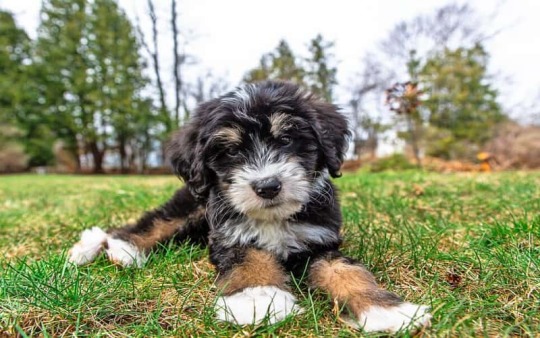
How the media portrays the breed
Bernedoodles are popular because they look nice and are nice dogs. They have been shown in a lot of different kinds of media. They're often in books, calendars, and other things with dogs on them. Also, because they are popular on social media sites, they are often shown in online articles, photos, and videos that show off how cute and appealing they are.
In the end,
In conclusion, Bernedoodle puppies are a popular and sought-after breed known for their cute looks, friendly personalities, and coats that don't bother people with allergies. Bernese Mountain Dogs and Poodles were bred together to make them. They are the best of both breeds that made them. Bernedoodles are loyal, smart, and able to adapt, which makes them great family pets and companions.
You need to train and socialize your Bernedoodle puppy as soon as possible if you want it to grow up to be a well-behaved, well-adjusted dog. For training sessions to go well, use positive reinforcement, stay consistent, and be patient. For their overall health, it's important to teach them how to deal with common behavior problems and to keep their minds and bodies active.
Care and maintenance include regular trips to the vet, a balanced diet, exercise, and brushing. It's very important to keep an eye on their health and take care of any problems right away. In a responsible way to breed Bernedoodle puppies, the health and happiness of the puppies come first. Find a breeder you can trust, or think about getting a pet from a rescue group.
Even though not many people know about individual Bernedoodle puppies, the breed as a whole is becoming more popular and has been featured in pop culture. They are popular pets and are often praised in the media because they are cute and friendly.
It's exciting to choose a Bernedoodle puppy. You can find a great friend who will bring you joy and love if you do your research and think about it.
0 notes
Text
Exploring the Exquisite Colors and Coat Types Available in Mini Bernedoodle Puppies for Sale at Rose Canyon Doodles
Introduction:
Welcome to Rose Canyon Doodles, your premier destination for delightful Mini Bernedoodle puppies. As a reputable breeder, we take great pride in offering a variety of colors and coat types in our Mini Bernedoodle puppies for sale. In this comprehensive blog post, we will delve into the enchanting world of these adorable pups, highlighting the diverse palette and coat variations that make them so special.
Understanding Mini Bernedoodle Genetics:
Before we embark on this exciting journey through the various colors and coat types of Mini Bernedoodle puppies, let's briefly touch upon the genetics that contribute to their charming appearances. Mini Bernedoodles are a crossbreed between a Bernese Mountain Dog and a Miniature Poodle. This unique blend results in an array of colors and coat textures that can captivate anyone's heart.
The Fascinating Color Palette:
At Rose Canyon Doodles, we strive to offer a kaleidoscope of colors to ensure that every potential owner finds the perfect match. Mini Bernedoodle puppies in our care exhibit a spectrum of hues, including:
Black Mini Bernedoodles: These elegant pups boast a luxurious black coat, often with distinctive white markings.
Brown Mini Bernedoodles: Also known as Chocolate Mini Bernedoodles, their deep brown coats exude warmth and coziness.
Tricolor Mini Bernedoodles: With a harmonious blend of black, white, and brown, tricolor Mini Bernedoodles are truly captivating.
Sable Mini Bernedoodles: Sable pups display a mix of colors, usually with a darker shade on their backs and lighter colors on their legs and face.
Phantom Mini Bernedoodles: Phantom-coated pups have a two-tone color pattern, typically with distinct markings on their face, legs, and chest.
The Enchanting World of Coat Types:
Beyond their mesmerizing colors, Mini Bernedoodles puppies for sale at Rose Canyon Doodles showcase various coat textures, each with its own charm:
Wavy Coats: Often described as low-shedding and allergy-friendly, wavy-coated Mini Bernedoodles have a soft, gentle wave to their fur.
Curly Coats: Curly Mini Bernedoodles are known for their adorable curls, resembling their Poodle parent. They are also hypoallergenic, making them ideal for allergy sufferers.
Straight Coats: Some Mini Bernedoodles have straight coats, combining the features of both parent breeds. While they may shed slightly more than wavy or curly-coated pups, they are equally charming and easy to care for.
Choosing Your Ideal Mini Bernedoodle:
With such a diverse range of colors and coat types available, finding the perfect Mini Bernedoodle puppies for sale at Rose Canyon Doodles is an exciting journey. However, it's essential to consider your lifestyle, preferences, and the characteristics of each coat type to make an informed decision. Whether you prefer a hypoallergenic curly-coated pup or a striking tricolor Mini Bernedoodle, our knowledgeable team is here to assist you in finding your dream companion.
Conclusion:
At Rose Canyon Doodles, we take immense joy in offering Mini Bernedoodle puppies for sale with a wide variety of colors and coat types. Our commitment to responsible breeding ensures that each pup receives the love, care, and socialization they need to become loving, well-rounded family members. If you are ready to embark on a wonderful journey with a Mini Bernedoodle by your side, don't hesitate to contact us. Together, we'll find the perfect furry friend to fill your life with endless joy and companionship.
0 notes
Text
Choosing the right dog breed for your family is an important decision. There are many factors to consider, such as size, temperament, and energy level. Here are the top 20 dog breeds for families, along with details and reasons why they make great family pets:
1. Labrador Retriever: A friendly and energetic breed that is great with kids. They are known for their loyalty and intelligence, making them easy to train.
2. Golden Retriever: A gentle and affectionate breed that is great with children. They are also highly trainable and intelligent, making them a great choice for families.
3. Bulldog: A calm and friendly breed that is great for families. They are known for their loyalty and affectionate nature, and they require less exercise than some other breeds.
4. Beagle: A friendly and curious breed that is great with kids. They are also highly adaptable and can live in both urban and rural environments.
5. Poodle: A highly intelligent and trainable breed that is great for families. They come in a variety of sizes, making them a good choice for families with different needs.
6. Boxer: A playful and energetic breed that is great with children. They are also protective of their families and make excellent watchdogs.
7. Collie: A gentle and loyal breed that is great with kids. They are also highly intelligent and trainable, and they make great family pets.
8. Bernese Mountain Dog: A gentle and affectionate breed that is great with children. They are also highly adaptable and can live in a variety of environments.
9. Cavalier King Charles Spaniel: A friendly and affectionate breed that is great with kids. They are also highly adaptable and can live in both urban and rural environments.
10. Vizsla: An energetic and playful breed that is great with children. They are also highly trainable and intelligent, making them easy to teach.
11. Bichon Frise: A friendly and playful breed that is great with kids. They are also hypoallergenic, making them a good choice for families with allergies.
12. Newfoundland: A gentle and loyal breed that is great with children. They are also highly adaptable and can live in a variety of environments.
13. Australian Shepherd: A highly intelligent and trainable breed that is great for families. They are also highly energetic and require plenty of exercise.
14. Cocker Spaniel: A friendly and affectionate breed that is great with kids. They are also highly adaptable and can live in both urban and rural environments.
15. Dalmatian: A playful and energetic breed that is great with children. They are also highly trainable and make great family pets.
16. Shih Tzu: A friendly and affectionate breed that is great with kids. They are also hypoallergenic, making them a good choice for families with allergies.
17. Irish Setter: A friendly and playful breed that is great with children. They are also highly energetic and require plenty of exercise.
18. German Shepherd: A loyal and protective breed that is great for families. They are also highly trainable and make excellent watchdogs.
19. Miniature Schnauzer: A friendly and playful breed that is great with kids. They are also hypoallergenic, making them a good choice for families with allergies.
20. American Staffordshire Terrier: A friendly and loyal breed that is great with children. They are also highly adaptable and can live in a variety of environments.
In conclusion, choosing the right dog breed for your family is an important decision. The breeds listed above are great choices for families due to their friendly and affectionate nature, loyalty, and adaptability. When choosing a family dog, it is important to consider your family's lifestyle and needs to ensure a good match.
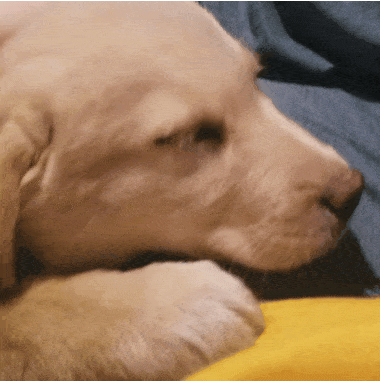
0 notes
Text
Bernedoodle: Full Profile, History, and Care
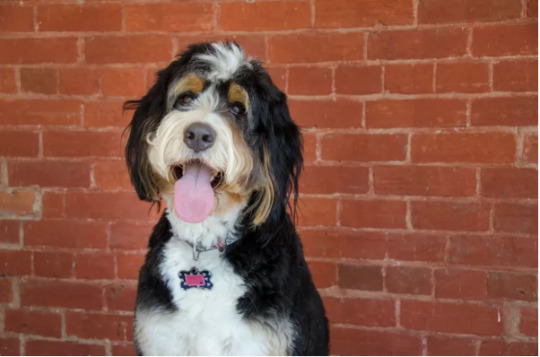
Bernedoodle, a mix of Bernese Mountain Dog and Poodle, is a relatively new hybrid breed that is becoming increasingly popular due to its adorable looks and friendly nature. These dogs are known for their intelligence, playful behavior, and low-shedding coat, making them a perfect pet for families who want an active and lovable companion. In this article, Meowk9 will provide a full profile, history, and care tips for Bernedoodles.
Breed Overview:
- GROUP: Hybrid
- WEIGHT: Standard: 50 to 90 pounds; miniature: 25 to 49 pounds; tiny: 10 to 24 pounds.
- HEIGHT: Standard: 23 to 29 inches tall at the shoulder; miniature: 18 to 22 inches; tiny: 12 to 17 inches.
- COAT: Variable; usually wavy to curly.
- COLOR: Variable; the most common colors are black, black and white, black and brown, or tri-color.
- LIFE EXPECTANCY: Variable depending on size; generally 12 to 17 years.
Profile of Bernedoodle
Appearance
Bernedoodles come in a variety of sizes and colors, depending on the size and coat of their parent breeds. Typically, they have a curly, wavy, or straight coat that can be black, brown, white, or a combination of these colors. They have a stocky and muscular body, a broad head, and floppy ears. The size of Bernedoodles can vary from small to large, depending on whether they are bred from a standard, miniature, or toy poodle.
Temperament
Bernedoodles are known for their friendly, sociable, and gentle temperament. They are easy to train, eager to please, and love to play. They get along well with children and other pets and are a perfect fit for families who want an active and affectionate companion. Bernedoodles also have a protective instinct, which makes them excellent watchdogs.
Health
Bernedoodles are generally healthy dogs, but like any other breed, they can be prone to certain health issues. The most common health problems in Bernedoodles include hip dysplasia, eye problems, allergies, and ear infections. It's important to take your Bernedoodle to regular checkups with a veterinarian and to maintain their overall health with a balanced diet and regular exercise.
History of Bernedoodle
Bernedoodles were first bred in the early 2000s in the United States, as a designer breed that combines the best traits of Bernese Mountain Dog and Poodle. The goal was to create a hypoallergenic and low-shedding dog that has the friendly nature of Bernese Mountain Dog and the intelligence of Poodle. Since then, Bernedoodles have become increasingly popular as a family pet.
Care for Bernedoodle
Exercise
Bernedoodles are an active breed that requires regular exercise to stay healthy and happy. They enjoy daily walks, playtime in the backyard, and other activities that stimulate their mind and body. Bernedoodles can adapt to different lifestyles, so they can be a good fit for apartment living or a house with a large yard.
Grooming
Bernedoodles have a low-shedding coat, which means they require regular grooming to prevent matting and tangling. Depending on their coat type, they may need to be brushed every day or every other day. Bernedoodles also need to be bathed every few months and have their nails trimmed regularly.
Diet
Bernedoodles require a balanced and nutritious diet to maintain their overall health. It's important to feed them high-quality dog food that is free from artificial preservatives, fillers, and by-products. Consult with a veterinarian to determine the right amount of food and feeding schedule for your Bernedoodle, based on their age, weight, and activity level.
Training
Bernedoodles are intelligent dogs that are eager to please, which makes them easy to train. They respond well to positive reinforcement training methods, such as rewards and praise. Early socialization and obedience training are essential to ensure that your Bernedoodle grows up to be a well-behaved and obedient companion.
Health
Regular checkups with a veterinarian are important to maintain the overall health of your Bernedoodle. It's important to ensure that they are up to date on their vaccinations and preventive medications for heartworm, fleas, and ticks. It's also important to monitor their weight and to provide them with regular exercise to prevent obesity and related health issues.
FAQs about Bernedoodles
Are Bernedoodles hypoallergenic?While no dog is completely hypoallergenic, Bernedoodles are considered a low-shedding breed, which means they produce fewer allergens than other breeds. This makes them a good choice for people with allergies.Do Bernedoodles get along with children?Yes, Bernedoodles are known for their friendly and gentle nature, and they get along well with children. They are a good fit for families with kids.How much exercise do Bernedoodles need?Bernedoodles are an active breed that requires at least 30-60 minutes of exercise per day. They enjoy walks, playtime, and other activities that stimulate their mind and body.Are Bernedoodles easy to train?Yes, Bernedoodles are intelligent and eager to please, which makes them easy to train. Positive reinforcement training methods work well with this breed.How long do Bernedoodles live?Bernedoodles have a lifespan of 12-15 years, depending on their size and overall health.
Conclusion
Bernedoodles are an adorable and friendly breed that make great pets for families. They have a low-shedding coat, are easy to train, and enjoy regular exercise. It's important to provide them with proper care, including regular grooming, a balanced diet, and preventive healthcare. If you're looking for a loyal and affectionate companion, consider adding a Bernedoodle to your family.
Read the full article
0 notes
Video
📘•°•📙Breeds Adult Coloring Book | +150 beautiful dog's breeds | Mindfulness and Anti-Stress Coloring (Anxiety Coloring Book)📙•°•📘
📣👉Available On Amazon👈💥
🛒👉Here is the Book link:
Breeds Adult Coloring Book :- https://amzn.to/3Kmipos
📘✍Author by MeLaMarco
✨️✨️✨️✨️✨️✨️✨️✨️✨️✨️✨️✨️✨️✨️✨️✨️✨️✨️✨️✨️
📙🖋This coloring book features more of 150 dog breeds from around the world, each beautifully illustrated on its own page. Whether you're a fan of cute and cuddly lap dogs, or athletic and powerful hunting dogs, this book has something for everyone. Each breed is unique traits and characteristics, making it a fun educational tool for dog lovers of all ages. So grab your colored pencils and unleash your creativity as you bring each breed to life with color!
✍ Dog's Breeds in this Adult Coloring Book:
Affenpinscher, Afghan Hound, Airedale Terrier, Alaskan Malamute, American Staffordshire Bull Terrier, Anatolian Shepherd Dog, Australian Cattle Dog, Australian Kelpie, Australian Shepherd Dog, Australian Silky Terrier, Australian Terrier, Basenji, Basset Fauve de Bretagne, Basset Hound, Beagle, Bearded Collie, Bedlington Terrier, Belgian Shepherd Dog Groenendael, Belgian Shepherd Dog Laekenois, Belgian Shepherd Dog Malinois, Belgian Shepherd Dog Tervueren, Bernese Mountain Dog, Bichon Frise, Bloodhound, Border Collie, Border Terrier, Borzoi, Boston Terrier, Bouvier des Flandres, Boxer, Bracco Italiano, Briard, Brittany, Bull Terrier, Bull Terrier Miniature, Bulldog, Bullmastiff, Cairn Terrier, Cavalier King Charles Spaniel, Cesky Terrier, Chesapeake Bay Retriever, Chihuahua (Smooth Coat)
📣📕📗
⭐️⭐️⭐️ By MeLaMarco (Author)
💗💖"
🛒👉Available Instantly on Amazon – Paperback
Order Now:-https://amzn.to/3Kmipos
Dog's Breeds Adult Coloring Book :-
👉👉 Buy Now:- 👇👇
https://amzn.to/3Kmipos
#DogsBreedsAdultColoringBook#MeLaMarco#coloringbooksforadultsrelaxationdogs#adultcoloringbookdogbreeds#DogColoringBook#LovableDogsColoringBook#Arttherapydogs#AnxietyReliefArtTherapyAdultColoringBookDog#ArtTherapyAdultColoringBookDogs#KindleBook#Paperback
1 note
·
View note